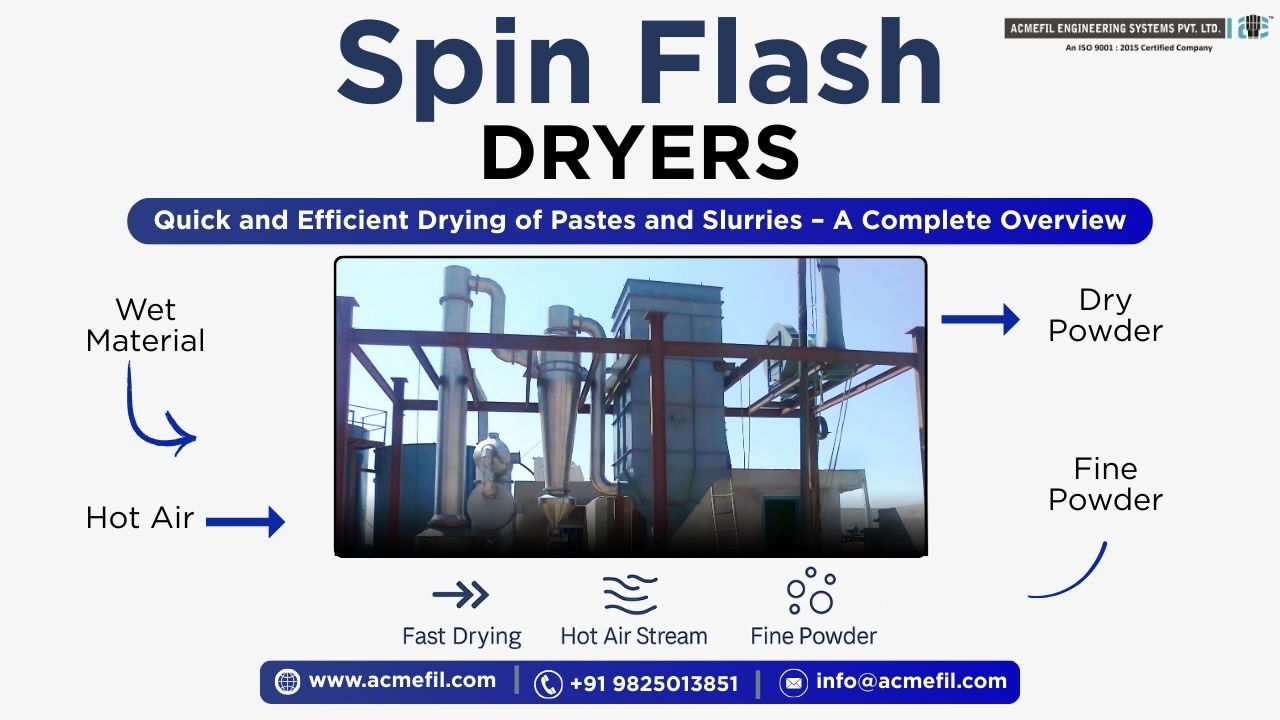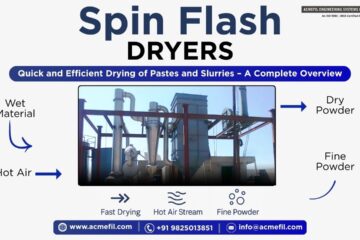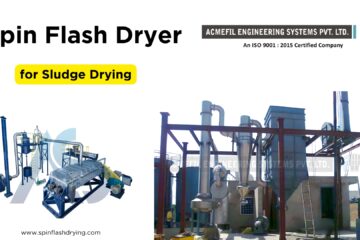Have you ever wondered how certain powdered products maintain such consistent quality and texture? Or how industries efficiently transform liquid solutions into perfectly dried powders on a massive scale? The answer often lies in specialized drying technology that most consumers never see. Spin flash dryers represent one of the most innovative and efficient drying solutions available to modern manufacturers, revolutionizing production processes across pharmaceutical, food, chemical, and numerous other industries. Understanding spin flash dryers is essential for anyone involved in industrial processing where product quality, energy efficiency, and operational costs are paramount concerns.
Table of Contents
What Are Spin Flash Dryers?
Spin flash dryers are advanced industrial drying systems designed to rapidly transform liquid materials into dry powder form through a specialized process that combines rotational force, heated air, and precise engineering. Unlike conventional drying methods, spin flash dryers utilize centrifugal action to create fine droplets that dry almost instantaneously when exposed to hot gas streams, resulting in uniform, high-quality powder products with exceptional characteristics.
The technology behind spin flash dryers represents a significant advancement in drying engineering, offering solutions to challenges that traditional drying methods cannot effectively address. These sophisticated systems operate on principles that maximize moisture removal efficiency while maintaining product integrity – a critical balance that many industries struggle to achieve with conventional equipment.
How Spin Flash Dryers Work: The Core Technology
Understanding the operational mechanics of spin flash dryers requires examining their distinct components and processing stages. The drying process can be broken down into several key phases:
Feed Introduction System
The process begins with the feed introduction system, where the liquid material (often called slurry, solution, or suspension) enters the dryer. This system typically includes:
- Pumping mechanisms calibrated for precise flow control
- Pre-conditioning equipment that adjusts material consistency
- Feed nozzles designed for optimal distribution into the drying chamber
The feed system’s design directly impacts the quality of the final product, as it determines how evenly the material will be exposed to the drying medium.
Atomization Process
What truly distinguishes spin flash dryers is their distinctive atomization mechanism:
- The liquid feed enters a rotating disk or wheel
- Centrifugal force propels the material outward at high velocity
- This action breaks the liquid into microscopically small droplets
- The atomized particles are immediately exposed to heated gas
This atomization creates an enormous surface area-to-mass ratio, allowing for extraordinarily rapid moisture removal compared to other drying technologies. The spinning component typically operates at 5,000-15,000 RPM, creating droplets ranging from 20-150 microns in diameter.
Drying Chamber Design
The specially engineered drying chamber is where the magic happens:
- Hot gas (typically air, nitrogen, or another process gas) flows through in a controlled pattern
- The atomized droplets interact with this heated gas stream
- Moisture evaporates almost instantaneously due to the droplets’ high surface area
- The chamber’s geometry facilitates proper particle flow and prevents wall adhesion
Temperature control within the chamber is absolutely critical, with typical operating ranges between 150-600°C depending on the specific application and material properties.
Separation and Collection
Once dried, the powder must be efficiently separated from the gas stream:
- Cyclone separators or bag filters capture the powder particles
- The separation efficiency directly impacts product yield and quality
- Collection systems are designed to maintain product integrity during handling
- Secondary filtering may be employed to capture ultra-fine particles
The entire process—from liquid feed to final powder collection—often occurs in mere seconds, making spin flash drying one of the most efficient drying technologies available.
Key Advantages of Spin Flash Dryer Technology
The growing adoption of spin flash dryers across various industries is driven by their numerous advantages over traditional drying methods:
Superior Product Quality and Consistency
Spin flash dryers excel at producing powders with:
- Consistent particle size distribution
- Excellent flowability characteristics
- Uniform moisture content throughout the batch
- Enhanced stability and shelf life
- Precise control over final product properties
These quality attributes are particularly valuable in industries with stringent specifications, such as pharmaceuticals and specialty chemicals.
Enhanced Energy Efficiency
From an operational perspective, spin flash dryers offer:
- Lower energy consumption per unit of water removed
- Reduced drying times compared to conventional methods
- More efficient heat transfer due to the atomization process
- Opportunities for heat recovery to further improve efficiency
- Smaller carbon footprint compared to many alternative drying technologies
Studies have shown that properly designed spin flash dryer systems can reduce energy costs by 15-30% compared to traditional spray dryers for certain applications.
Space and Footprint Optimization
Modern manufacturing facilities value spatial efficiency, and spin flash dryers deliver:
- Compact design relative to their production capacity
- Vertical configuration that minimizes floor space requirements
- Integration capabilities with existing production lines
- Modular designs that allow for expansion as production needs grow
- Reduced infrastructure requirements for installation
Process Flexibility and Control
One of the most valuable aspects of spin flash dryers is their adaptability:
- Ability to handle heat-sensitive materials through precise residence time control
- Adjustable operating parameters to accommodate different product specifications
- Capability to process a wide range of feed viscosities
- Automatic control systems that ensure consistent operation
- Quick changeover potential between different products
Industries Benefiting from Spin Flash Dryer Technology
The versatility of spin flash dryers makes them valuable across numerous sectors:
Pharmaceutical Applications
In pharmaceutical manufacturing, spin flash dryers provide:
- Gentle drying of active pharmaceutical ingredients (APIs)
- Production of free-flowing powders for tablet compression
- Preservation of chemical structures for heat-sensitive compounds
- Consistent particle size for predictable dissolution rates
- Sterile processing capabilities when required
Food and Dairy Industry Implementation
Food processors utilize spin flash dryers for:
- Production of instant food powders and ingredients
- Whey protein concentrate and isolate processing
- Encapsulation of flavors and nutritional additives
- Creation of specialty food ingredients with enhanced functionality
- Preservation of heat-sensitive vitamins and nutrients
Chemical Industry Utilization
Chemical manufacturers rely on spin flash dryers for:
- Drying of specialty chemicals and intermediates
- Processing of pigments and colorants
- Production of detergent powders and cleaning agents
- Drying of catalysts and industrial additives
- Creation of polymer powders with specific characteristics
Biotechnology and Research Applications
Emerging applications include:
- Processing of biomaterials and bioactive compounds
- Drying of cell culture media and biological derivatives
- Production of specialized research-grade materials
- Creation of encapsulated biological agents
- Preservation of sensitive biochemical compounds
Technical Considerations When Selecting a Spin Flash Dryer
For engineers and technical professionals evaluating drying systems, several factors require careful consideration:
Material Properties Analysis
The physical and chemical properties of the feed material significantly impact dryer performance:
- Viscosity ranges and how they affect atomization
- Heat sensitivity and maximum allowable temperature exposure
- Stickiness or glass transition characteristics
- Particle size requirements for the final product
- Chemical stability during the drying process
Capacity and Throughput Requirements
Production needs must be clearly defined:
- Required hourly or daily powder output
- Batch versus continuous processing requirements
- Scalability needs for future production increases
- Seasonal demand variations
- Maintenance downtime considerations
Energy Source and Consumption
Energy considerations include:
- Available heating utilities (steam, natural gas, electricity)
- Waste heat recovery opportunities
- Energy efficiency targets and sustainability goals
- Variable energy costs and their impact on operational expenses
- Regulatory requirements regarding emissions and energy use
Control Systems and Automation
Modern spin flash dryers incorporate sophisticated control technologies:
- PLC or DCS control platforms for process management
- Real-time monitoring of critical parameters
- Automated adjustment capabilities for process optimization
- Data logging for quality assurance and regulatory compliance
- Integration with plant-wide control systems
Optimization Strategies for Spin Flash Dryer Operation
Maximizing the performance of spin flash drying systems requires attention to several key operational aspects:
Feed Preparation and Conditioning
Proper feed preparation significantly impacts overall system efficiency:
- Pre-concentration to reduce moisture content before drying
- Temperature adjustment to optimize viscosity
- Addition of processing aids when appropriate
- Removal of impurities that may affect product quality
- Homogenization to ensure uniform drying characteristics
Operating Parameter Adjustment
Fine-tuning operational settings can dramatically improve results:
- Optimizing inlet and outlet temperatures
- Adjusting atomizer speed for ideal particle size
- Balancing feed rate with drying capacity
- Controlling gas flow patterns within the chamber
- Managing residence time based on material requirements
Maintenance Best Practices
Preventive maintenance ensures reliable operation:
- Regular inspection of atomizing components for wear
- Cleaning protocols to prevent product buildup
- Monitoring of heating systems for efficiency
- Inspection of separation equipment for optimal performance
- Calibration of instrumentation and control systems
Energy Recovery Systems
Implementing energy recovery can significantly reduce operating costs:
- Heat exchangers to capture waste heat
- Recirculation of process gas where applicable
- Thermal insulation to minimize heat loss
- Variable frequency drives for energy-efficient motor operation
- Scheduling production to optimize energy utilization
Common Challenges and Solutions in Spin Flash Drying
Despite their advantages, spin flash dryers present certain challenges that require proper management:
Product Adhesion and Buildup
Some materials tend to stick to dryer surfaces:
- Challenge: Material buildup on chamber walls and atomizer components
- Solution: Optimized chamber design with appropriate wall temperatures
- Solution: Special surface treatments or coatings to reduce adhesion
- Solution: Automated cleaning systems for continuous operation
- Solution: Process parameter adjustments to modify particle characteristics
Heat Sensitivity Management
Heat-sensitive materials require special consideration:
- Challenge: Product degradation due to temperature exposure
- Solution: Ultra-short residence time configurations
- Solution: Two-stage drying with controlled temperature profiles
- Solution: Nitrogen or inert gas drying for oxidation-sensitive materials
- Solution: Advanced control systems for precise temperature management
Scale-up Considerations
Moving from pilot to production scale presents unique challenges:
- Challenge: Maintaining product attributes during scale-up
- Solution: Computational fluid dynamics modeling for accurate design
- Solution: Pilot testing with scalable equipment configurations
- Solution: Staged implementation with performance verification
- Solution: Parametric analysis to identify critical scaling factors
Recent Innovations in Spin Flash Dryer Technology
The field continues to evolve with several notable advances:
Hybrid Drying Systems
Combining multiple drying technologies creates synergistic benefits:
- Integration of spin flash with fluid bed processing for specialized applications
- Multi-stage systems that optimize energy use across different drying phases
- Combination with microwave or infrared heating for enhanced performance
- Integrated cooling capabilities for temperature-sensitive products
- Sequential processing systems for complex materials
Advanced Material Handling
Improvements in material handling enhance overall system performance:
- Non-contact feeding systems for sensitive materials
- Advanced atomizer designs for difficult-to-process liquids
- Aseptic processing capabilities for sterile products
- Continuous powder handling systems with minimal operator intervention
- Automated cleaning and changeover systems for multi-product facilities
Digital Twinning and Simulation
Digital technology is transforming spin flash dryer design and operation:
- Real-time digital modeling of drying processes
- Predictive maintenance using advanced analytics
- Process optimization through machine learning algorithms
- Virtual commissioning to reduce startup time
- Operator training through simulation tools
Economic Analysis: Cost-Benefit Considerations
Investment in spin flash drying technology requires thorough financial analysis:
Capital Investment Factors
The initial investment includes:
- Base equipment costs for the dryer system
- Auxiliary equipment and integration expenses
- Installation and commissioning costs
- Validation expenses for regulated industries
- Training and technology transfer costs
Operational Cost Analysis
Ongoing expenses include:
- Energy consumption costs (often the largest operating expense)
- Maintenance and spare parts requirements
- Labor for operation and maintenance
- Cleaning and changeover costs
- Quality control and testing expenses
Return on Investment Calculations
ROI is driven by several factors:
- Increased product quality leading to higher market value
- Reduced waste and improved yield compared to alternative methods
- Energy savings over the equipment lifetime
- Reduced labor costs through automation
- Extended product shelf life and stability
Lifecycle Cost Considerations
Long-term financial planning should account for:
- Expected equipment lifespan (typically 15-25 years)
- Upgrade paths to accommodate future requirements
- Residual value at end-of-life
- Regulatory compliance costs over time
- Technology obsolescence risks
Environmental and Sustainability Aspects
Modern manufacturing increasingly prioritizes environmental performance:
Emissions and Air Quality
Spin flash dryers impact air quality through:
- Particulate emissions from exhaust streams
- Volatile organic compound (VOC) releases depending on feed materials
- Control technologies such as bag filters and scrubbers
- Regulatory compliance requirements for air permits
- Monitoring and reporting obligations
Water and Waste Management
Process impacts extend to:
- Cleaning water requirements and disposal
- Potential for water recycling within the process
- Waste powder management and recycling options
- Handling of off-specification product
- Cleaning agent selection and environmental impact
Carbon Footprint Considerations
Sustainability metrics include:
- Direct energy consumption and associated carbon emissions
- Indirect environmental impacts from raw material preparation
- Comparative carbon footprint against alternative drying methods
- Opportunities for renewable energy integration
- Life cycle assessment of environmental impacts
Future Trends in Spin Flash Drying Technology
The evolution of this technology continues in several promising directions:
Process Intensification
Next-generation systems will likely feature:
- Enhanced heat and mass transfer for even faster drying
- Multi-functional equipment combining drying with other unit operations
- Intensified designs that reduce equipment size and energy requirements
- Novel atomization approaches for specialized applications
- Continuous manufacturing integration for end-to-end processing
Industry 4.0 Integration
Digital transformation is reshaping drying technology:
- Internet of Things (IoT) connectivity for real-time monitoring
- Artificial intelligence for process optimization
- Augmented reality tools for maintenance and operator training
- Blockchain for traceability in regulated industries
- Remote monitoring and management capabilities
Specialized Applications Development
New markets continue to emerge:
- Nanomaterial processing with enhanced control
- Advanced ceramic powder production
- Specialty polymers with precise characteristics
- Engineered biomaterials for medical applications
- Novel food ingredients with enhanced functionality
FAQs About Spin Flash Dryers
What makes spin flash dryers different from spray dryers?
While both technologies atomize liquids for drying, spin flash dryers utilize mechanical centrifugal force rather than pressure nozzles for atomization. This results in more uniform particle size, better energy efficiency for certain applications, and often a smaller equipment footprint. Spin flash dryers typically have shorter residence times, making them suitable for heat-sensitive materials that might degrade in conventional spray dryers.
What feed materials work best in spin flash dryers?
Spin flash dryers excel with moderately viscous liquids, slurries, and suspensions, particularly those requiring tight particle size distribution in the final product. They’re especially effective for materials that benefit from the intense but brief heat exposure characteristic of the process. Materials with viscosities ranging from 1-500 centipoise typically perform well, though specialized designs can accommodate materials outside this range.
How do spin flash dryers compare in energy efficiency?
The energy efficiency of spin flash dryers typically surpasses conventional tray or tunnel dryers by 30-50% for comparable applications. When compared to spray dryers, the advantage varies by application but often ranges from 10-25% improvement due to more efficient atomization and heat transfer. The actual efficiency depends significantly on proper system design, feed properties, and operational parameters.
What maintenance challenges are common with spin flash dryers?
The primary maintenance concerns include wear on the atomizing components due to high rotational speeds, potential material buildup on chamber walls, and maintaining proper alignment of high-speed rotating parts. Regular inspection of the atomizer, heating systems, and separation equipment is essential. Most modern systems are designed for easy access to critical components, minimizing downtime during scheduled maintenance.
Can spin flash dryers handle heat-sensitive materials?
Yes, their extremely short residence time (often less than one second) makes them excellent choices for heat-sensitive compounds. By precisely controlling the exposure time and temperature profile, these dryers can successfully process enzymes, proteins, probiotics, and pharmaceutical compounds that would degrade in conventional drying systems. Special configurations using lower temperatures and inert gas environments further enhance their suitability for sensitive materials.
Conclusion
Understanding spin flash dryers reveals their significant role in modern industrial processing across multiple sectors. Their unique combination of rapid drying, uniform product quality, energy efficiency, and process flexibility makes them invaluable tools for manufacturers facing increasingly demanding production requirements and competitive pressures. As industry continues to evolve toward more sustainable, efficient, and precise manufacturing methods, spin flash drying technology will likely play an expanding role in producing the high-quality powdered products that consumers and industrial users demand.
The continued innovation in spin flash dryer design, control systems, and application engineering promises even greater capabilities in the future. For process engineers, production managers, and business leaders in manufacturing industries, gaining a thorough understanding of this technology provides a competitive advantage in an environment where production efficiency and product quality are paramount concerns. Whether you’re evaluating new equipment investments, optimizing existing processes, or developing innovative products, the principles and applications of spin flash drying represent essential knowledge in the modern industrial landscape.
Looking for advanced industrial drying solutions for your manufacturing process? Acmefil Engineering Systems Pvt. Ltd., an ISO 9001:2015 certified company established in 1992, specializes in designing and manufacturing state-of-the-art spin flash dryers that deliver unmatched performance and efficiency. Our spin flash dryers feature precision engineering, customizable configurations, and industry-leading energy efficiency – perfect for pharmaceutical, food, chemical, and other demanding applications. With over 800 successful installations nationwide and comprehensive turnkey solutions, Acmefil remains the trusted partner for businesses seeking reliable, high-performance industrial drying and concentrating equipment backed by decades of expertise.




